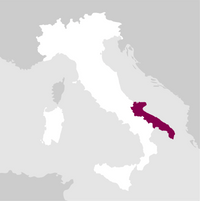Description
It is the most typical product, obtained exclusively from “Bombino Bianco” grapes, an indigenous vine that the Casa d’Araprì has successfully tested as a base wine able to be sparkling with the Classic Method. The technique of the first fermentation in wood gives to the RN a shimmering gold colour, a scent full of ripe fruit and hints of vanilla. Notes are tasty, full-bodied and complex.
Awards
Details

Perlage

Perfume

Color

Taste
Serve at:
06 - 08 °C.
Longevity:
05 - 10 years

Pairings
- Start up year: 1979
- Oenologist: Girolamo d'Amico
- Bottles produced: 180.000
- Hectares: 19
D’Arapri started from the belief of the three friends to produce quality sparkling wine in the South and the intuition – then proved to be successful – to valorize in the "bubbles" the Capitanata’s native grape variety "Bombino bianco". D’Arapri developed thanks to the founder’s business skills and the extraordinary attachment to values of their own terrotory.
This is how Girolamo d’Amico, Louis Rapini and Ulrico Priore have created, in 1979, the popular and renowned production of sparkling wines "d’Araprì" (the mark is given by the first letters of the three surnames readed in sequence). D’Arapri is the only company in Puglia that produces sparkling wines with the classic method, based on fermentation in the bottle, also called method "Champenoise". Read more


| Name | D'Arapri RN Metodo Classico Brut 2019 |
|---|---|
| Type | White classic method sparkling wine brut |
| Denomination | Daunia IGT |
| Vintage | 2019 |
| Size | 0,75 l |
| Alcohol content | 12.5% by volume |
| Grape varieties | 100% Bombino Bianco/Trebbiano d'Abruzzo |
| Country | Italy |
| Region | Apulia |
| Vendor | D'Arapri |
| Origin | San Severo (Foggia). |
| Climate | Altitude: 80 00 m. a.s.l. Exposure: South and South-West. |
| Soil composition | Clayey limestone with a slight slope. |
| Cultivation system | Espalier and trellised "pergola" system. |
| Plants per hectare | Espalier: 3,500 plants per hectare. Pergola: 2,000 plants per hectare. |
| Yield per hectare | 10,000 2,000 kg/hectare. |
| Harvest | By hand, in late September, with manual selection of the grapes. |
| Wine making | First fermentation in 300-litre tonneaux with a stay on the lees until January. |
| Aging | Each bottle rests for a minimum of 36 months, protected from light, wind and shocks, at a temperature of 13°C, in the basement of the company's cellar. Disgorgement à la glace, with the addition of the dosage syrup, about two months before marketing. |
| Allergens | Contains sulphites |





